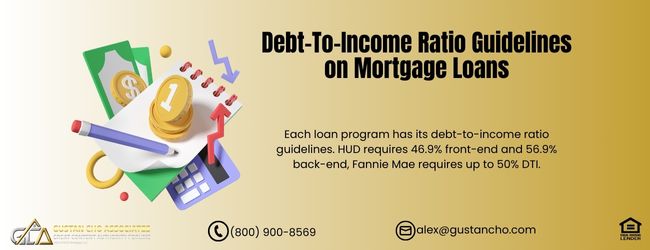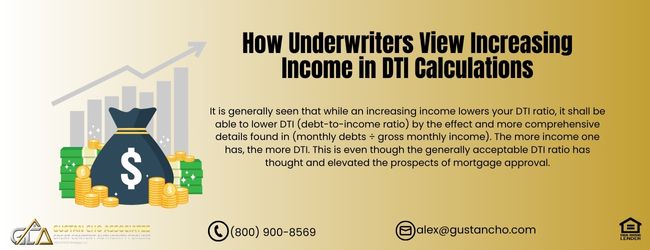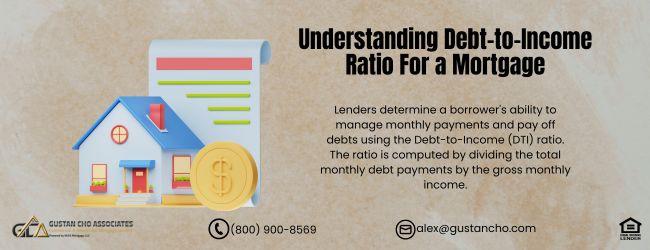Debt-To-Income Ratio Guidelines on Mortgage Loans

This article will cover the updated debt-to-income ratio guidelines on government, conventional, jumbo, and non-QM loans at GCA FORUMS Mortgage Group. All home mortgage programs have agency guidelines when it comes to debt-to-income ratios. Chad Bush, a dually licensed loan officer and real estate agent at GCA FORUMS Mortgage Group explains debt-to-income ratio guidelines as follows:
If homeowners have a homeowner’s association fee, that monthly fee is calculated as part of the monthly housing payment when calculating the front-end debt-to-income ratio. Only qualified income can be used when calculating debt-to-income ratios.
The updated guidelines on debt-to-income ratios on traditional conventional loans at GCA FORUMS Mortgage Group is 50% DTI. GCA FORUMS Mortgage Group has non-QM jumbo loan program that only requires a 660 credit score with 10% down payment. There are no maximum debt-to-income ratio on VA loans for borrowers with sufficient residual income. Borrowers can have debt-to-income ratios up to 65% DTI on VA loans with an approve/eligible.
Front-End and Back-End Debt-To-Income Ratio Guidelines
The back-end debt-to-income ratio is the sum of all monthly debts divided by the borrower’s qualified income. The front-end debt-to-income ratio is the housing payment divided by the borrower’s monthly gross income. The monthly housing payment includes the principal, interest, taxes, insurance, or PITI. Fannie Mae and Freddie Mac set agency mortgage guidelines on conventional loans. The maximum debt-to-income ratio on conventional loans is 50% DTI. There is no front-end debt-to-income ratio caps on conventional loans. Besides the full-time income of the borrower, other income can also be used as long as it is considered qualified income. FHA, VA, USDA, and Conventional loans have agency guidelines on debt-to-incomes. Speak With Our Loan Officer for Mortgage Loans
Debt-To-Income Ratio Guidelines on FHA Loans
To get an approved/eligible per automated underwriting system (AUS) on FHA loans, the maximum front-end DTI cannot exceed 46.9%, and the maximum back-end DTI cannot exceed 56.9%. Alex Carlucci, Vice President of Mortgage Lending at GCA FORUMS Mortgage Group, is a manual underwriting expert on FHA and VA loans. Here is what Alex Carlucci said about manual underwriting:
The only difference between manual versus automated underwriting system on FHA and VA loans is the DTI reduction on manual underwrites. Underwriters has discretion on extending the debt-to-income ratio caps on manual underwriting.
Manual underwriting debt-to-income ratios on FHA loans depend on the number of compensating factors. The maximum debt-to-income ratios on manual underwriting FHA loans is 31% front-end and 43% back-end with no compensating factor. 37% front-end and 47% back-end with one compensating factor. Maximum debt-to-income ratio guidelines on FHA loans is 40% front-end and 50% back-end with two compensating factors. We will discuss more on debt-to-income ratios on manual underwriting FHA loans in the next paragraph.
Debt-To-Income Ratio Manual Underwriting Guidelines on FHA Loans
One month’s reserves are required for manual underwriting. The maximum debt-to-income ratios on FHA manual underwriting is as follows:
- 31% front-end and 43% back-end DTI with no compensating factors
- Maximum of 37% front-end and a maximum of 47% back-end DTI with one compensating factor
- Maximum of 40% front-end and a maximum of 50% back-end DTI with two compensating factors
Compensating factors are important for borrowers with higher debt-to-income ratios on manual underwriting.
What Are Compensating Factors
Compensating Factors are very important when it comes to manual underwriting. The following are considered compensating factors for manual underwriting on FHA loans:
- Low payment shock of 5% or less or no greater than $100 from what the borrower was paying for rent and the new housing payment
- Reserves of three months or more are considered compensating factors
- Having a second job or other qualified income for at least one year that is not used in qualifying for the home mortgage
- A habit of saving money and reserves
- Larger down payment than the minimum of the 3.5% down payment required
- Longevity in the same job or field and consistent periodic promotions and pay raises
FHA and VA loans are the only two home mortgage programs that allow manual underwriting. VA and FHA have similar mortgage guidelines regarding manual underwriting about debt-to-income ratio caps. VA is more lenient when it comes to debt-to-income ratios on manual underwrites. We can stretch the maximum debt-to-income ratio to 55% on VA loans with compensating factors. Click Here to talk with our loan officer for mortgage loans
Mortgage Guidelines Debt-To-Income Ratios on VA Loans
VA loans are the best home mortgage program in the nation. However, you must be eligible with a certificate of eligibility (COE) to qualify for VA loans. Only active and retired U.S. military members with a COE are eligible for VA loans. VA loans have no down payment requirements. Lenders can offer 100% financing at competitive mortgage rates without insurance on VA loans due to the government guarantee. Then why is it that most lenders have a minimum credit score requirement? This is because of lender overlays. All lenders need to have their borrowers meet the minimum VA Agency Mortgage Guidelines.
What Are Lender Overlays?
Lenders can have higher lending requirements above and beyond the minimum VA Agency Guidelines called lender overlays. GCA FORUMS Mortgage Group is one of the few lenders with no lender overlays on VA loans. Dale Elenteny of GCA FORUMS Mortgage Group said the following about VA loans:
There is no maximum debt-to-income ratio requirement with an approve/eligible per automated underwriting system on VA loans. There are no minimum credit score requirements on VA loans.
However, lenders can impose minimum credit score requirements and maximum debt-to-income ratio caps on VA loans. GCA FORUMS Mortgage Group only goes by the automated underwriting system’s automated findings and has no additional lender overlays. VA loans have no maximum loan limit, annual mortgage insurance, minimum credit score requirements, or maximum debt-to-income ratio caps.
Debt-To-Income Ratio Guidelines on USDA Loans
Lenders offer 100% financing on USDA loans due to the government guarantee of the USDA. USDA loans are only limited to areas where the USDA classifies the area eligible for USDA loans. There are maximum household income restrictions. The maximum front-end DTI is 29%, and the maximum back-end cap is 41%. USDA loans are a very popular loan program in rural areas that enable homebuyers to purchase a home with no down payment required. USDA loans are very popular in Southern and Western states with rural areas.
Fannie Mae and Freddie Mac Debt-To-Income Ratios Guidelines on Conventional Loans
Conventional loans are often referred to as conforming loans. This is because conventional loans need to conform to Fannie Mae or Freddie Mac Guidelines. Conventional loans do not have a maximum front-end debt-to-income ratio cap. The maximum debt-to-income ratio cap on conventional loans is 50% DTI. Non-QM lenders have debt-to-income ratio guidelines depending on the lender. Some non-QM lenders can cap it at 41% while other lenders go higher. Non-QM loans generally have a maximum cap on debt-to-income ratio guidelines up to 50%. Speak With Our Loan Officer for Conventional Loans
FAQ on Debt-to-Income Ratio Guidelines
Here are some frequently asked questions and answers in the Tolerance Debt-to-Income Ratio Guidelines for government, conventional, and non-QM loans.
What is a Debt-to-Income Ratio DTI Ratio?
Answer: The determined debt-to-income (DTI) ratio is a financial measure that lenders employ to assess one’s capacity to make monthly payments and repay any debts owed. It is determined by the total amount a borrower spends on monthly debt repayments divided by gross income earned. In this case, lenders use this ratio to determine the degree of risk the borrower poses.
How is the DTI Ratio Computed?
Answer: The DTI formula is obtained when all your monthly debt obligations (such as a mortgage, car payment, student loan, monthly credit card obligations, etc.) are added, and the total is divided by your preliminary monthly gross earnings (before taxation). This statement is shown in percentage form.
DTI Formula
- DTI = (Total Monthly Debt Payments divided by Gross Monthly Income)×100
- For example, if your monthly debt payments are $2,000 and your GMI is $6,000, the DTI ratio is 33%.
What Are the Debt-to-Income Ratio Guidelines Concerning a Mortgage Loan?
Answer: Maximum DTI should be understood, as with all aspects, in a relative way and is determined by the particular loan type:
- Conventional Loans: The DTI is generally expected to be at most 45%. However, some lenders may allow as much as 50%, provided borrowers have compensating factors such as higher scores and larger payments towards the loan yield.
- FHA Loans: In practice, the maximum debt-to-income ratio guidelines for FHA loan qualification would be 46..9% front-end and 56.9% back-end on automated underwriting approval files. Manual underwriting debt-to-income ratio guidelines depend on the number of compensating factors.
- VA Loans: VA loans do not have a set maximum debt-to-income ratio guidelines. With strong residual income, you can have a debt-to-income ratio as high as 65%.
- USDA Loans: The average maximum total debt-to-income ratio guidelines on USDA loans is 29% front-end and 41% back-end. However, some exotic higher levels of DTI have been negotiated in case there are strong counterbalancing strengths in other areas.
- Non-QM Loans: About Non-Qualified Mortgages (non-QM), the DTI threshold can be higher, up to 55%, but the loans usually have higher interest rates, terms, and conditions.
Which DTI ratio is appropriate when qualifying for a mortgage?
Answer:
- Attention must also be focused on each borrower’s debt-to-income (DTI) ratio, with the ideal percentage being 45% and below for most lenders.
- The majority of conventional loans, more specifically the A-paper loan, need a DTI value of about 45% or even lower.
- The lower the DTI, the less risky the borrower is regarded by the lenders regarding their ability to service the mortgage within the required amounts fully.
How Does High DTI Impact Mortgage Application?
Answer:
- A high DTI ratio is likely to affect loan qualifications.
- This is because it indicates to lenders the amount of earned income that will go toward the repayment of current debts.
- This implies that the chances are high that the borrower will default on the mortgage payments.
- As a result, when the debt-to-income ratio exceeds the LTV requirements.
- Lenders would compensate by needing some credit score, cash in reserves, or a down payment.
Can Borrowers Apply For a Mortgage With a High DTI Ratio?
Answer:
- You can still have a high DTI and be approved for a mortgage loan.
- This is especially true for FHA, VA, or non-QM loans with minimal DTI requirements.
- Nevertheless, compensating factors will be needed.
- Such requirements include a larger down payment, excellent credit score, or assets in liquid form.
- An answer to a delayed payment debt in your favor is to add a co-signer.
Name what counts as a debt that is considered in the DTI calculation.
Answer: The general categories that are included in the DTI estimate include:
- Payment associated with a monthly rent or mortgage.
- Lien or lease on vehicles.
- Money lent for educational purposes.
- Credit card bills.
- Loans taken.
- Payment for child/partner support.
- Exclusions: Utility bills, groceries & other basic sustenance must be considered for DTI calculation.
How does the student loan debt influence my DTI ratio when seeking a mortgage loan?
Answer:
- Student loan debt affects your DTI ratio quite heavily.
- If you do not make your payments, they will include the monthly amount you are expected to pay on a student loan and put it under the DTI.
- Whether you are on a pay-as-you-earn model or a fixed-amount repayment plan does not matter.
- If your loans are still being paid through foreclosures or voluntary quitting.
- Some lenders take a certain amount of your total loan as a figure (typically 0,50% for FHA loans) to compute your monthly payment.
Distinguish between front-end and back-end DTI ratios.
Answer:
- Front-end DTI Ratio: This is the ratio of the total amount spent on housing to the gross monthly income for the month.
- It includes expenses on housing loans, taxes, insurance, and HOA fees.
- This is best pegged at 31% or less.
- This category includes all your monthly obligations, housing, car loans, and credit cards.
- This is the DTI ratio most commonly used by lenders and is preferable at 45% and below for the conventional types of loans.
What if I want to reduce DTI so that my mortgage chances increase?
Answer: Your chances of being approved for a mortgage will increase if you lower your DTI. Several ways can help in lowering your DTI:
Pay down existing debt: Target liabilities with higher fees, such as credit cards, personal loans, or car loans, and try paying them off.
Increase income: Any increase in income (such as raises, side jobs, or even bonuses) will improve your DTI because it increases the income portion of the equation.
Refinance or consolidate loans. Reduce DTI. Reducing your buttocks to the thighs is possible, which makes me laugh.
How do I manage my monthly DTI Overview rate if I am self-employed?
Answer:
- Most lenders will attempt to calculate DTI using net income (after all expenses) for self-employed individuals. DTI management strategies include the paperwork supporting all your business expenditures is very good.
- Most lenders, including those yielding income with a commission base, will usually average your earnings over the last two years.
- Thus, consistency is essential.
Consolidate personal obligations to avoid increasing the monthly DTI ratio through income-earning activities.
What happens when my DTI slightly exceeds the limit set for it?
Answer:
- When most DTI approaches the allowable maximum, it does not necessarily mean you are not approved.
- Other factors that can help offset this include earning potential.
- Income reserve and valuable asset potential.
- The down payment amount is relative to the total investment property value.
- Consistent and stable employment.
- History of good employment.
What’s The Difference Between Debt-to-Income Ratio Guidelines on FHA Loans Compared to Other oans?
Answer:
- FHA loans are more relaxed regarding maximum DTI than other loan types. With regards to FHA loans:
- Generally, there is a 46.9% front-end and 56.9%% back-end DTI ratio limitation.
- As a borrower on this type of loan, the maximum DTI level you will face is 46.9% front-end and 56.9% back-end.
- Though some lenders accept lower due to their lender overlays.
- You will find more relaxed terms on these types of loans, and a borrower can get a 46.9%-56.9% DTI limit, depending on the Lender compensating reasons.
In what way does the credit score I possess influence how the DTI ratio calculator accepts the credit score?
Answer:
- If the credit score is strong enough, creditors may be willing to accommodate a larger DTI ratio.
- This is because the borrower is perceived as a lower risk.
- For example, you could have a DTI a little above the normal limit of 45 percent.
- However, if your credit score exceeds 700, you may still get a conventional loan with a DTI of 50%.
- With lower scores, however, most subprime borrowers will have to cut back on their DTI to accommodate the additional risk.
Is the income for DTI calculated based on gross or net?”
To compute the DTI ratio, lenders use gross income, the amount before deductions such as tax. Therefore, the ratio only considers the overall amount, not the disposable income today. Lenders do this because self-employed borrowers use their net income after business operating costs.
Your Debt-to-Income (DTI) ratio is one of the most important factors in getting a mortgage loan. Although every loan program has requirements, working to lower or increase DTI ratios can increase your chances of getting a mortgage loan.







Responses